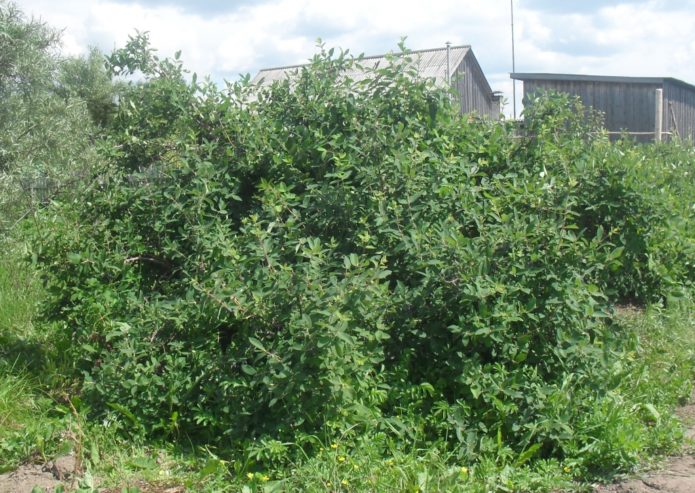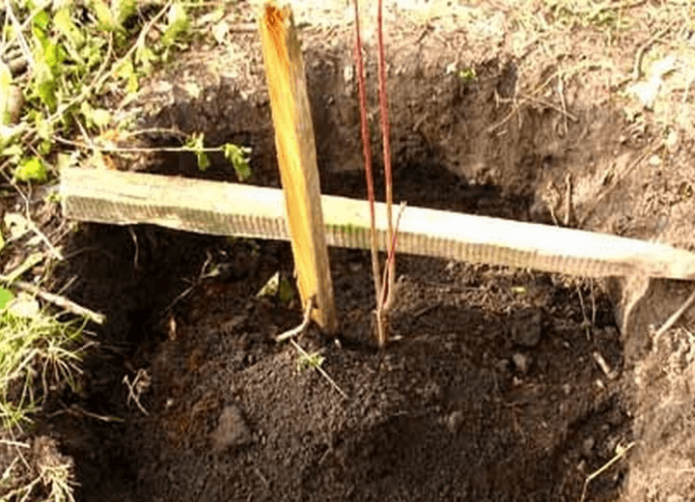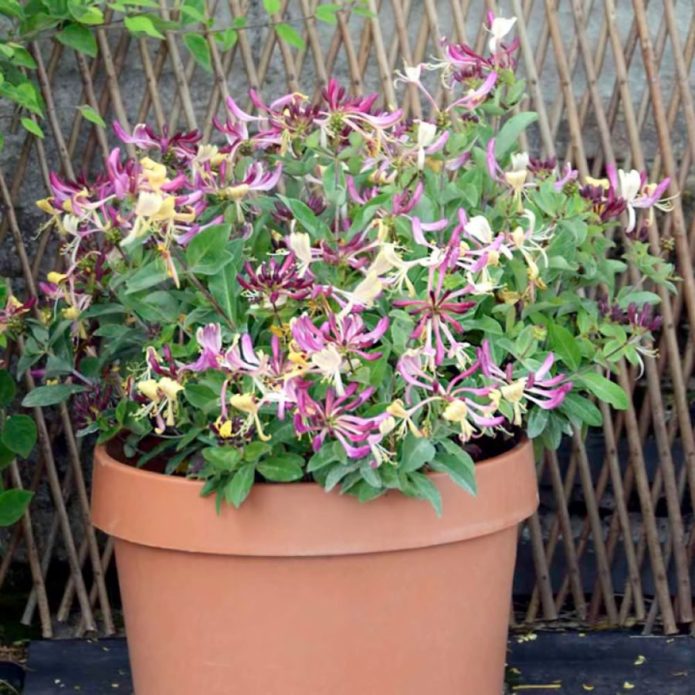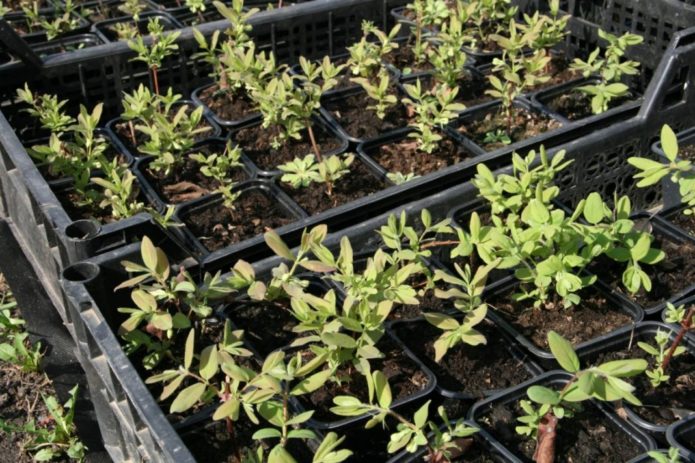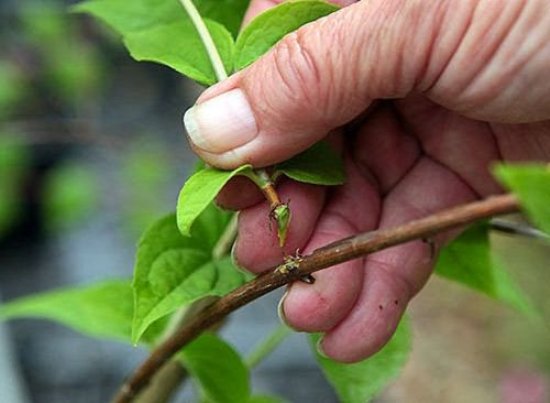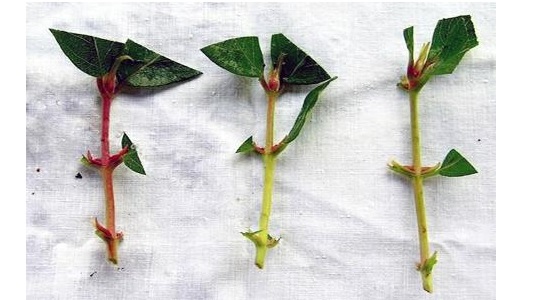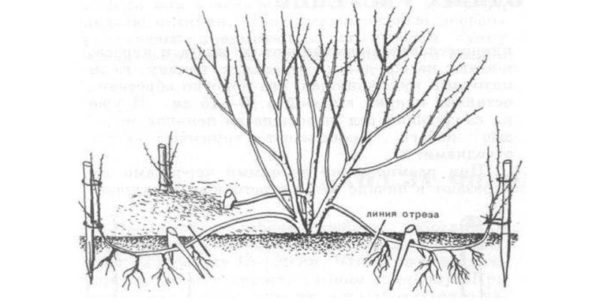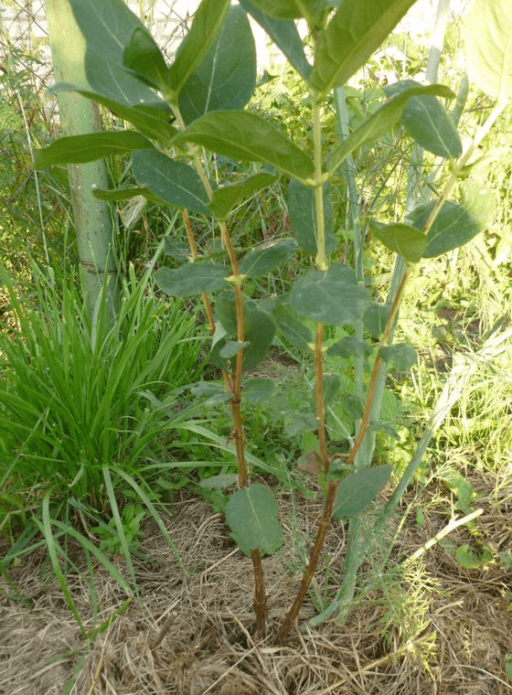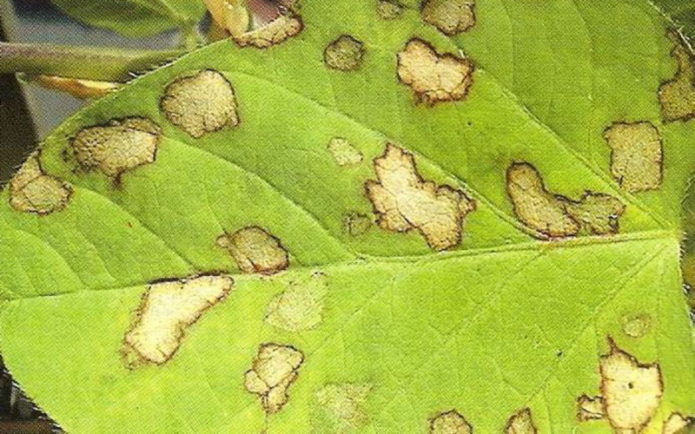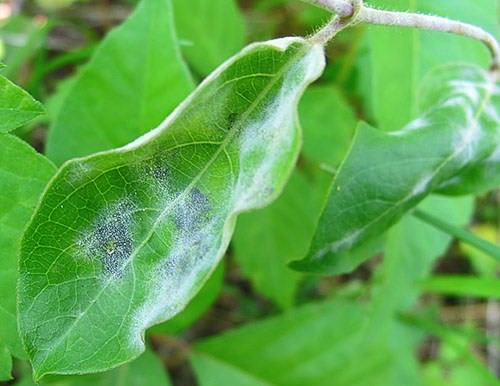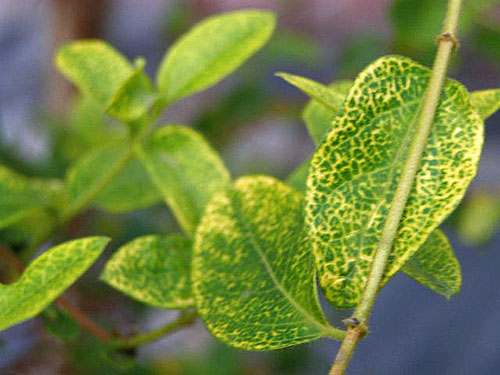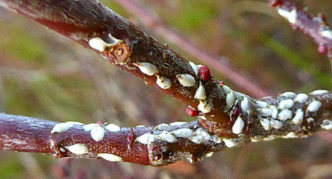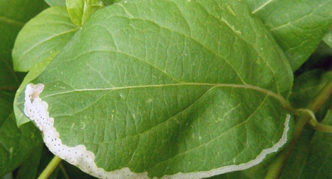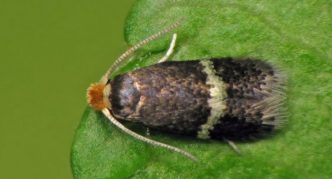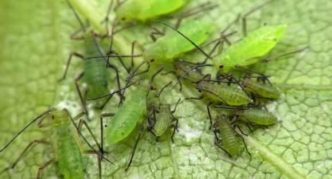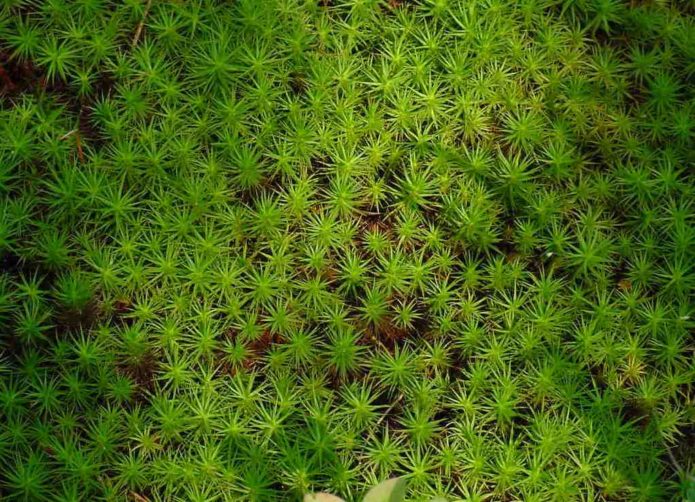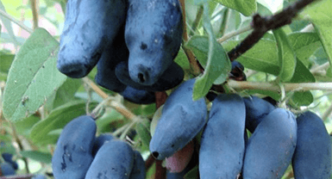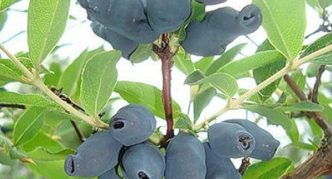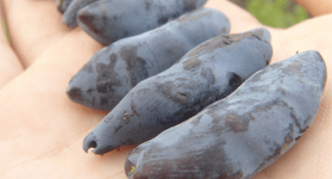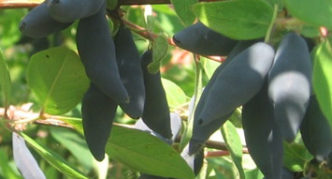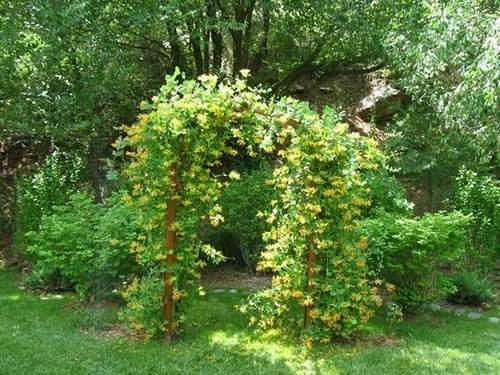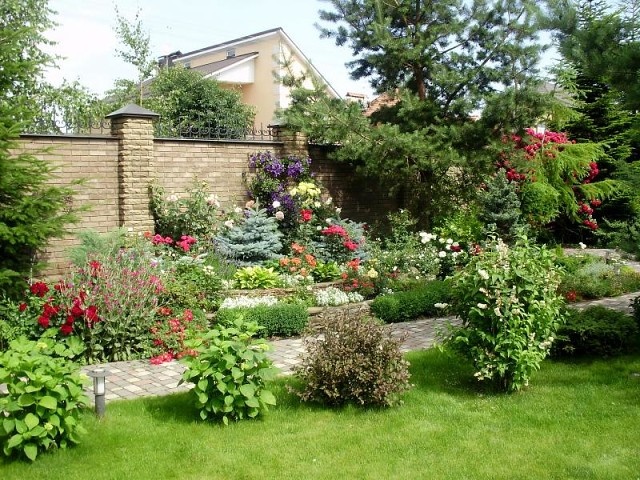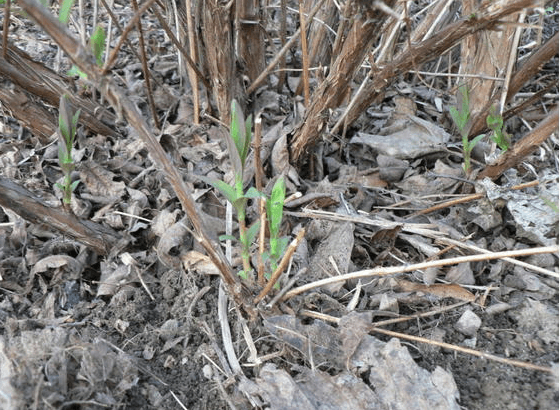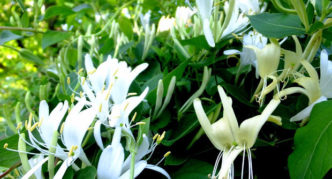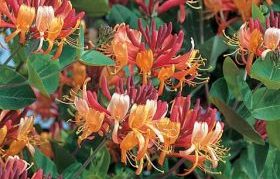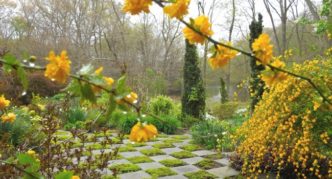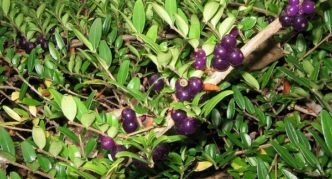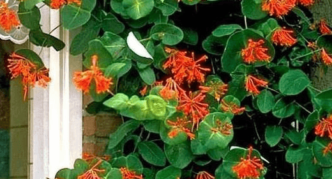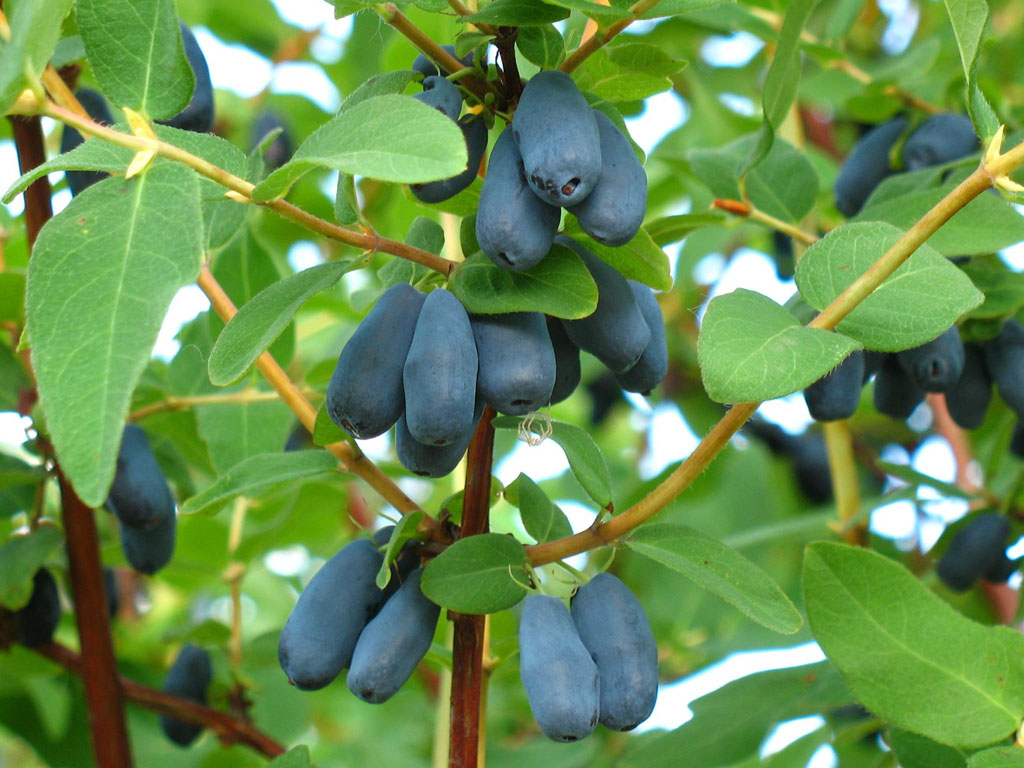Originally, honeysuckle was a beautiful wild-growing shrub. It still grows in the mountains and forests of Southeast Asia. And in our country, garden honeysuckle is popular, it can be decorative (its small round berries are inedible) and edible (its blue oblong fruits sometimes ripen before garden strawberries). To get an early harvest of delicious berries or to admire the flowering of ornamental shrubs, it is important to know the features of reproduction, cultivation and care that this crop needs.
Content
Growing honeysuckle
Honeysuckle begins to bloom one of the first horticultural crops, attracting the eye, tired of the dull monotony of the winter landscape. The decorativeness of this plant allows it to be planted in the foreground of the site. The result is a bright accent that complements and emphasizes the beauty of the primroses that bloom in early spring. But apart from beautiful flowers, the edible varieties of honeysuckle yield delicious berries - the first vitamins of summer.

Honeysuckle is one of the first garden shrubs to produce berries - if spring is friendly, you can try them already at the end of May
Seat selection
A flat, sunny area is suitable for honeysuckle. It is not recommended to plant it in lowlands. In spring, the plant wakes up early, and it is in such areas that the cold air stagnates the longest. This is bad for the development of the bush. Honeysuckle can tolerate a little shade, but yields are reduced. The plant is appreciated for the fact that the berries ripen earlier than strawberries (almost two weeks).
Planting time is also important for better survival. This is best done in September or October. The plant takes root calmly and winters well.Honeysuckle transplanted in spring grows worse, since the growing season begins early.
What is the vegetation of plants and how does it proceed with specific examples of individual horticultural crops:https://flowers.desigusxpro.com/en/uhod-za-rasteniyami/vegetaciya-rasteniy-chto-eto-i-kak-takoy-period-protekaet.html
Planting a honeysuckle bush
The planting process takes place in several stages.
- Dig a hole 40 × 40 × 40 cm in advance.
- Humus (1 bucket), double superphosphate (100 g), wood ash (300 g) and potassium sulfate (30 g) are added to it. Everything is mixed well with the earth. If the pit is prepared in the spring and planted in the fall, then several times over the summer it will be useful to mix the soil in it for better aeration of the soil.
- When planting, the roots are carefully straightened and sprinkled with earth. The root collar should be 3–5 cm below the soil level.
- After watering, the land is mulched with sawdust, pine needles or grass. If the branches of the seedling are not damaged, then pruning is not needed.
Honeysuckle is a great honey plant, but one plant is not enough. For annual abundant fruiting, you need to have 2-3 bushes of different varieties on the site, with the same flowering time.
Honeysuckle care
You need to care for this beautiful shrub in the same way as for any other. Performing all the necessary procedures will make it possible to get a rich harvest.
Watering features
Honeysuckle is a moisture-loving culture, but it does not tolerate stagnant water: it can lead to decay of the roots. A slight drying out of the soil is not terrible for the shrub, but with a prolonged absence of moisture, the surface roots die.
The lack of watering during flowering and during the ripening period of the crop leads to the fact that the berries will be very bitter. In hot weather, frequent watering is necessary (at least 10 liters of water per bush).
Where, when and how many honeysuckle bushes are best planted in their summer cottage:https://flowers.desigusxpro.com/en/yagody/zhimolost-kak-sazhat.html
Suitable fertilizers
In order to get good harvests every year, fertilize regularly. Honeysuckle must be fed at least three times per season:
- in early spring, urea is poured under each bush, dissolving 1 tbsp. a spoon in a bucket of water;
- after picking berries, nitroammofoska is introduced (30 g per 10 l of water);
- in late autumn, a mixture is made of 5 kg of organic matter (rotted), 100 g of wood ash and 40 g of double superphosphate per adult plant.
The need for pruning
If the edible honeysuckle bush is not thickened, it is not pruned. If necessary, in the spring, remove frozen, broken and low-growing branches.
Video: pruning honeysuckle in spring
When pruning a bush in the fall, you cannot remove the growth of the current year, since the main part of the fruit buds is on it. To rejuvenate old plants, all shoots are removed, except for young shoots.
You must trim the decorative honeysuckle. The features of its formation will be discussed below.
Growing honeysuckle in containers
Due to the fact that honeysuckle has shallow roots, it can be grown as a container crop, especially for ornamental varieties. Nowadays, container gardens are in vogue, when plants, including trees and shrubs, are grown in large pots or barrels. This makes it possible to change the appearance of your green corner by moving the pots and composing new compositions. Growing honeysuckle in a container will require more frequent watering, additional fertilizing during the summer, and for the winter you will have to cover the container well or move it to a basement where the temperature will stay around 0 ° C.
Reproduction of honeysuckle
The plant can be propagated in various ways:
- seeds,
- cuttings,
- layering,
- dividing the rhizome.
Not all of them are effective enough.
Simple and effective ways of breeding honeysuckle in a summer cottage:https://flowers.desigusxpro.com/en/yagody/kak-zhimolost-razmnozhit.html
Growing from seeds
This is the most time consuming of all, but the least effective method. The properties of the mother plant are not preserved, and the quality of the fruits is usually much worse than the original ones. It is used in the development of new varieties of honeysuckle. To get seeds:
- Several of the ripe berries are smeared with a thin layer on the paper.
- Allow to dry.
- For sowing next year, seeds on paper are harvested in a dry place, where they are stored for no more than two years. After this period, seed germination decreases.
You can sow them right away. The procedure for this will be as follows:
- Seeds are laid out in containers with soil according to the 3 × 3 cm scheme.
- Lightly sprinkle them with earth, moisten and cover with foil or glass. Ventilate container periodically and spray with water as needed.
- After the emergence of shoots (after 3-4 weeks) the film is removed.
- When there are 2-3 true leaves on the sprouts, the seedlings dive according to the 15 × 15 pattern.
- During the season, the bed is constantly watered and loosened.
- The next year, the seedlings are transplanted, increasing the distance between them (approximately 20 × 20 cm).
- The first fruits will appear in 3-4 years. Of all the seedlings, they choose those whose berries you like best, and transplant them to a permanent place. The rest can be used for decorative plantings.
- Selected seedlings will begin to bear fruit fully in 7–8 years.
Honeysuckle propagation by cuttings
This method is much faster and allows you to maintain the qualities of the mother plant. There are several technologies for harvesting and sowing cuttings of perennial shrubs.
Annual cuttings
Prepare and sow cuttings as follows:
- In the spring, before the buds open, cut off annual shoots with a diameter of at least 7-8 mm and a length of 15-20 cm.
- They are buried in moist soil so that two buds remain on the surface, and covered with a film.
- In three to four weeks, the cuttings give roots and they are planted in the ground.
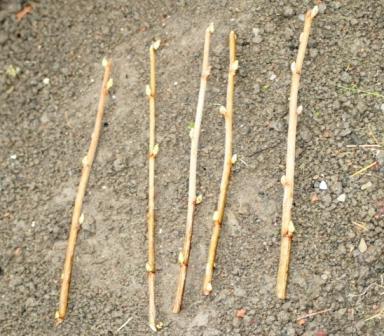
For cuttings, annual shoots of honeysuckle with a diameter of at least 7-8 mm and a length of 15-20 cm are suitable
Combined cuttings
Combined cuttings take root well. They are prepared and planted in this way:
- After flowering, in late May - early June, the green shoot is cut off so that it has a piece of a one-year-old twig (as in the photo).
- Cuttings are planted in the ground to a depth of 5 cm, watered and covered with foil.
- Two to three times a day, the cuttings are slightly moisturized.
- As soon as there is an increase at the top, it means that the roots have developed.
- The sprouts are left to winter, sheltered from frost.
- The seedlings are ready for transplanting next fall.
Green cuttings
Another option for cuttings is green. To plant them:
- In June, green twigs about 15 cm long are cut.
- All the lower leaves are removed, and a couple of the upper ones are cut in half.
- The cuttings are placed in a rooting stimulator.
- After the formation of the roots, the cuttings are planted in the ground and covered with a film. It is important to constantly keep the soil moist.
- A year later, in the fall, the plants are ready for planting in a permanent place.
Honeysuckle propagation by layering
Good seedlings are obtained with cuttings. One-year honeysuckle shoots are suitable for rooting. Layers are prepared as follows:
- The branch (usually the lower one) is bent to the ground, pinned with wire.
- Fall asleep with earth 2-3 cm.
- Water and mulch well. The rooting site should not dry out.
- The next year, the rooted shoot is separated from the bush with pruning shears and planted in a permanent place. Better to do this in the fall.
Rhizome division
Plants between 6 and 15 years old are suitable for this. Older bushes are physically difficult to divide, and the plant itself may die. The process consists of several steps:
- In early autumn, the bush is carefully dug up and cut so that each part to be separated has 1–2 healthy branches with good roots.
- The cut points are sprinkled with crushed charcoal.
- The resulting plants are planted.
The bush can be divided in the spring, but this must be done before the beginning of the growing season, no later than the end of March.
Honeysuckle diseases
It is believed that honeysuckle is quite resistant to disease, but this is not entirely true. It can be attacked by fungi and viruses. Timely care and preventive treatments of the bush reduce the likelihood of infection. The most common diseases of honeysuckle are various spots. Decorative and edible honeysuckle are closely related crops, so their diseases and pests are the same, as are the means of control.
White spot
The disease is caused by fungi. Greyish spots with a white center appear on young foliage. After the leaves, shoots are affected. The onset and spread of the disease is facilitated by high humidity and low air temperatures.
Honeysuckle is treated with any fungicide. Infected leaves and shoots are removed, all weeds are cleared around the bush.
Powdery mildew
Most often, plants growing in the shade are affected by powdery mildew. The branches seem to be sprinkled with ash. The affected shoots should be removed and burned, and the bushes should be treated with fungicides.
Reddish olive blotch
Sometimes red-yellow spots appear on young leaves, after which the leaves turn yellow and fall off. This manifests itself as a reddish-olive blotch.
To combat this disease, fallen leaves are removed and burned. Plants are treated with Bordeaux liquid or fungicides.

In case of honeysuckle disease with a reddish-olive spot, it is necessary to treat the bush with Bordeaux liquid
Tuberculariosis
The appearance of red bumps on the branches is another of the fungal diseases called tuberculariosis. It is accompanied by drying of the shoots. To prevent its spread, all affected shoots are cut and burned. In early spring and after flowering, the bushes are treated with Bordeaux liquid.
Blackening of branches
It so happens that young leaves and tips of the shoots seem to be charred. This is also a manifestation of a fungal disease that causes blackening of the branches. It is necessary to remove and burn all shoots where there are signs of disease. The bushes are treated in early spring and after flowering with Bordeaux liquid.
Viral diseases
In addition to fungal diseases, honeysuckle can also be affected by leaf mottling and mosaic-razuha viruses. There are no remedies for viral diseases of honeysuckle. If your plant shows signs of a viral infection, it is best to get rid of such a bush. In extreme cases, if the signs are isolated, you can carefully remove the affected shoots and burn them.
Honeysuckle pests
The list of insect pests in honeysuckle is not very large, but even the appearance of one of them does not bring joy to the gardener. The bush may be affected:
- aphids - plants are treated with tobacco dust infusion with the addition of a soap solution (100 g of tobacco and 100 g of soap per 10 liters of water);
- scabbards - 2 times during the summer, the bushes are sprayed with Rogor or Aktellik;
- baby moth - spray the honeysuckle with Aktellik, Fitoverm or Karbofos in late summer or early autumn, when the moth lays eggs;
- miner flies - they spray the bushes with Inta-Vir, Decis during the summer.
Photo gallery: pests of honeysuckle
- Scabbards attach to the young branches of the honeysuckle bush and suck the juice out of them
- Miner flies lay eggs in honeysuckle leaf plates
- From the eggs of the baby moth, amber-yellow caterpillars with a brown-red head appear, eating honeysuckle leaves
- Aphids feed on the sap of leaves and young shoots of honeysuckle
All insecticidal preparations are used strictly according to the instructions, observing safety measures.
Features of growing honeysuckle in the regions
Honeysuckle can be grown in various regions of Russia and neighboring countries.
Siberia and the Urals
The plant is characterized by high frost resistance. Honeysuckle blooms early, before the final establishment of warm weather. With recurrent frosts, flowers can withstand temperatures as low as –10 ° C. In addition, it is a fast-ripening crop: only 45-50 days pass from flowering to harvest. So in a short summer it grows successfully.
However, it is better to give preference to local varieties. For example, in the Tomsk region there is a specialized farm "Bochkarskoye", which is engaged in breeding new varieties and growing seedlings of various crops. They have a good selection of honeysuckle varieties suitable for the Siberian climate.
Buying a seedling is half the battle, it needs to be properly planted. It is better to stop your choice on a three-year-old plant with a closed root system (in a container). The cost of such seedlings is higher, but they are more persistent and take root better, and begin to bear fruit in the second year.
Planting is preferable in the fall, but the place should be prepared in the spring.
The procedure is as follows:
- The pit is made larger than usual (up to about 1 m).
- Rotted organic matter (compost), wood ash and complex mineral fertilizers (they have a balanced composition) are added to it.
- During the summer, the soil in the pit is periodically stirred for better aeration.
- In autumn, about a month before the onset of frost, the plants are planted, watered and mulched well. For this, needles, sawdust or sphagnum moss, which is abundant in Siberia, are suitable.
For cultivation, you can recommend varieties:
- Siberian,
- Yugan,
- Strezhevchanka,
- Delight.
North-East Non-Black Earth Region and the Komi Republic
In these regions, climatic conditions are also favorable for the cultivation of honeysuckle. The plant is timely prepared for the dormant period and tolerates wintering well.
Care is no different from other regions:
- timely watering,
- top dressing,
- trimming,
- if necessary, treatment against diseases and pests.
Such varieties grow and bear fruit well:
- Malvina,
- Gzhelka,
- Nizhny Novgorod,
- Delight,
- Bochkar's pride.
Belarus
In the Republic of Belarus, honeysuckle is also popular. She is unpretentious and does not require special care. It happens when it is still warm in late autumn, the plant blooms. This does not affect winter hardiness, but next year the harvest will be slightly less. The following varieties grow well and bear fruit on the territory of the republic:
- Blue spindle,
- Amazon,
- Cinderella.
South of Russia
In the south of Russia, due to the fact that in autumn the heat can be kept until October, and sometimes until November, and thaws are frequent in the middle of winter, honeysuckle can start to grow and bloom. All this has a bad effect on the condition of the plant and on its yield. For the rest, caring for a bush is no different from caring for any other region. Any variety can be planted here, even with a slight frost resistance.
Review of edible honeysuckle varieties
The first variety of honeysuckle in the State Register of Breeding Achievements of the Russian Federation was registered relatively recently, less than fifty years ago. But this does not mean that the choice of plants is limited. Quite the opposite. In such a short period of time, many varieties of both edible and decorative honeysuckle have been bred and successfully grown.
Table: the most famous varieties of edible honeysuckle
| Name | Berry ripening period | Characteristics of berries | Features of the variety |
| Zest | Early ripe | Sweet, with a slight bitterness, elongated | Medium-sized, frost-resistant |
| Gzhelka | Late maturing | Large, sweet, with a slight bitterness | Medium, dessert |
| Bochkar giant | Mid-season | Very large, up to 4 centimeters in length, sweet and sour taste | The frost resistance of the bush is up to –47 ° C. The flowers can withstand return frosts down to –10 ° C |
| Siberian | Early ripe | Fragrant, sweet, up to 2.5 cm long. | The bushes are medium-sized - up to 1.5 m, High frost resistance - up to –50 ° C. The variety is resistant to disease and drought |
| Roxanne | Late maturing | Large, sweet and sour. Falling capacity is average | High frost resistance, disease resistant |
| Delight | Early ripe | Large, sweet and sour, little crumble | Bushes are tall. The variety is frost-resistant, resistant to diseases |
| Malvina | Mid-season | Fragrant, sweet and sour taste, fusiform. Little falls | Medium-sized bush, good frost resistance |
| Bochkar's pride | Mid-season | Sweet and sour with a slight bitterness, characteristic shape, strongly crumble | The variety is frost and disease resistant, high yielding |
Photo gallery: some of the most famous varieties of edible honeysuckle
- Honeysuckle variety Raisin - frost-resistant
- Honeysuckle variety Gzhelka - dessert, its berries have a sweet taste
- The berries of the honeysuckle variety Bochkarsky giant are very large
- Berries of the Delight variety crumble a little
Ornamental honeysuckle: differences in cultivation
In the landscape design of sites, climbing and shrub honeysuckle is widely used. With its help you can:
- decorate an unsightly wall of a building;
- arrange a gazebo, arch;
- arrange a hedge.
Ornamental varieties are very plastic:
- climbing honeysuckle can be turned into a shrub by pruning or into a beautiful flower garden if grown without support;
- undersized varieties are good in border plantings;
- both climbing and shrub plants can be combined with conifers (thuja, junipers, spruce);
- honeysuckle with a short flowering period will look good next to climbing roses and clematis.
Ornamental honeysuckle care
A sunny, wind-protected area is suitable for decorative honeysuckle. When planting near buildings, the best spot will be on the south side. The plant tolerates light shading, but with a lack of illumination, there will be no abundant flowering. Honeysuckle will bloom more abundantly if several varieties are planted side by side.
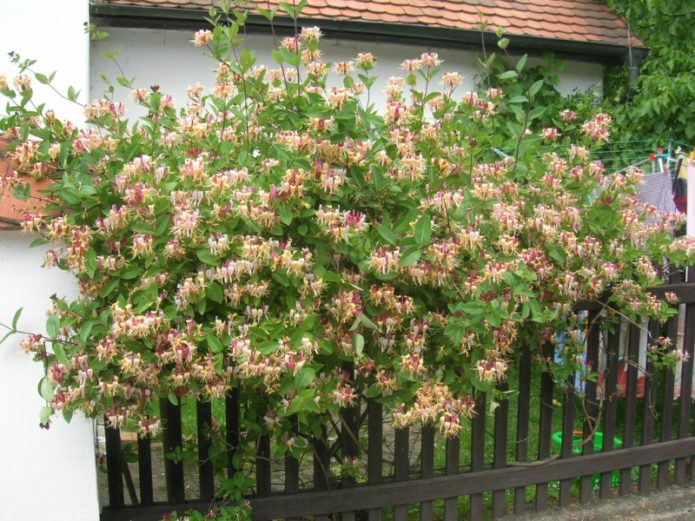
Best of all, honeysuckle will show its decorative qualities when planting from the south side of the house
Planting of this culture is the same as edible honeysuckle, only the root collar is left at the soil level.
Care includes:
- regular watering,
- weeding,
- loosening the soil,
- obligatory pruning.
The roots of ornamental honeysuckle are located deep enough, and loosening to a depth of 15–20 cm will not harm the plant, rather the opposite. On hot days, it is good to irrigate the whole plant.
Pruning for ornamental varieties is necessary... Plants grow quickly and without formative pruning it is impossible to maintain the shape set by the design. This procedure is carried out in early spring or late autumn. In addition, curly varieties rejuvenate once every two years. To do this, cut out all the old trunks and leave 3-5 young strong shoots.
Video: the formation of decorative honeysuckle
Abundantly and long-flowering plants consume a large amount of nutrients that need to be replenished, otherwise there will be few flowers next year. Top dressing is carried out three times per season (twice with mineral fertilizers and once with organic matter):
- for the first time in the spring in the bud phase, watered with water and urea (1 tbsp. spoon per 10 l);
- the second time after flowering (30 g of nitroammofoska per 10 liters of water);
- the third top dressing is carried out in late autumn, when, when digging the land, rotted manure and ash are brought under each bush (5 kg and 100 g, respectively).
If enough fertilizers and organic matter were applied when planting the plant, then the first 2-3 years nothing needs to be added.
Transplantation of adult plants is carried out during the dormant period, in early spring or autumn.
Reproduction methods
By breeding methods decorative honeysuckle does not differ from edible. It is best to propagate it by layering, especially curly varieties, as they take root well.
Root shoots are also a good breeding option. The plant does everything by itself. After rooting the shoot, you need:
- Dig out the growth carefully.
- Separate the root with a knife or pruner.
- Sprinkle the cut with crushed coal.
- Then plant the sprout in the prepared place.
Ornamental honeysuckle varieties
There are climbing varieties (they can grow on trellises or arches, or creep as ground covers) and bush varieties, from which they form stems.
Table: popular curly varieties of decorative honeysuckle
| Name | Length height | Flowering time | Flowers | Characteristics of the variety |
| Serotin | Up to 5 m | Blooms for a long time | Hot pink |
|
| Telman | Up to 5 m | June is about 2 weeks | Yellow | For the winter, they are removed from the support and covered. Goes well with conifers |
| Gerald | Up to 6 m | About 3 weeks in June | White and very aromatic | Does not shed leaves in frost of -25 ° C. In the spring, the leaves fall off when new ones begin to grow. Orange-red berries |
| Hekrota Goldflame | Up to 6 m | June to September | Outside blue-red or purple-red, inside yellow-white | Can be shaped like a bush. Doesn't give berries |
| American beauty | Up to 4 m | June to September | Sparkling orange | Low frost resistance. The fruits are inedible |
Photo Gallery: Some Popular Climbing Varieties of Ornamental Honeysuckle
- Seronina's honeysuckle variety can be used as a ground cover
- Gerald variety flowers are very fragrant
- American Beauty honeysuckle does not tolerate winter well
- Telman's honeysuckle variety goes well with conifers
Bush varieties and types of honeysuckle are more difficult to form, but no less decorative.
Table: popular bush varieties and types of decorative honeysuckle
| Name | Variety or species | Height | Flowering time | Flowers | Characteristics of the variety |
| Brown | Variety | Up to 3 m | June to October | The shape of the flowers resembles fuchsia, the color is red-orange | Berries are inedible, but used in traditional medicine |
| Hat | View | Low-growing bush - no higher than 30 cm | June to September | Fragrant, white | In landscape design it is used as a border culture. The berries are inedible. Evergreen |
| Alberta | Variety | Medium bush - up to 1.3 m | 3 weeks in June | Lavender, very aromatic | The variety is drought tolerant, but sensitive to frost |
| Alpine | View | Medium bush - up to 1.5 m | May to August | Odorless, greenish pink | Dense crown. Berries are inedible, cherry-like, decorative, bright red |
| Far Eastern | View | Includes 3 types of shrubs from 1 to 3 m in height | June to August | Yellowish white | Used for landscaping. The berries are inedible, coral red. Winter hardy look |
Photo gallery: some popular bush varieties and types of decorative honeysuckle
- Honeysuckle cauliflower blooms only in warm regions, in central Russia it is used due to the decorative shape of the bush
- Albert's honeysuckle variety does not tolerate frost
- Abundant flowering of Brown's honeysuckle can be expected only 3-4 years after planting
Reviews of edible honeysuckle
Advantages: the earliest berry, tasty, healing, unpretentious, frost-resistant shrub. Disadvantages: no. For four years now, honeysuckle, a low bush with berries, has been growing in my dacha. When I bought it, they explained to me that I need to buy in a pair, and I did. Honeysuckle berries appeared in the second year. The harvest is getting bigger every year.
Advantages: it has many useful properties. Disadvantages: Not for me. The very first berry that ripens in the country is honeysuckle.
Honeysuckle is a shrub that produces delicious berries. The honeysuckle berry is very tasty and has an unusual taste - bittersweet and sour, it also has many useful properties. When eaten, these berries are great for refreshing.
If you want to grow berries and decorate the site with a beautiful plant, but there is not enough free land, plant honeysuckle. The early fruiting period, incredible decorativeness, frost resistance and ease of care make this culture in demand today. And to everyone who doubts whether to plant honeysuckle or not, let me remind you that it is very useful for both adults and children.
